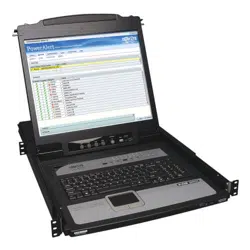Loading ...
Loading ...
Loading ...

19
6. KVM Operation
(
continued
)
6.6 Remote Session Operation
After you have successfully logged in (see Logging Into the B020-
Series KVM Switch section), the B020-Series KVM Switch OSD Main
Page appears with the Port Access tab selected:
Note: The AP Client and Local Console versions feature a Control
Panel in the top center of the screen that appears when scrolled
over with the mouse. The web browser version’s Control Panel is only
available when a port has been accessed. (See Control Panel section
for details.)
6.6.1 Control Panel
1. If your KVM is displayed in the Server List, connect to it by highlighting it and clicking on the Connect button.
Note: For a switch to show up in the Server List, the Enable Device List checkbox in the Operating Mode page (see 7.2.13 Operating Mode
for details) must be checked and the Program server port must match what is set in the Network page (see 7.2.14 Network for details)
2. If your KVM does not display in the Server List, enter in its IP address in the IP server field and click the Connect button.
3. Upon clicking the connect button, you will be prompted to enter your username and password. Enter in your username and password and
press OK.
4. When connected, the Remote View button will be activated. Click on it to access the KVM remotely. Click on the Disconnect button to log out
of the KVM switch.
All the ports that a user is permitted to access are listed in the Port
Selection panel at the left of the page. Ports to which users do not
have access will not be displayed in their OSD. Double-click a port
icon to access the device attached to it. Once you switch to a port, its
screen displays on your monitor. Depending on whether you have Full
Access or View Only access to the port, you may or may not be able
to operate the remote computer using your keyboard and mouse.
The Control Panel is provided as a way for the user to optimize and control the remote session. Regardless of whether you initiated a remote
session via the Windows or Java browser and non-browser clients, the control panel and its functionality remain the same. To display the Control
Panel, hover your mouse pointer over the top-center of the remote screen.
The Control Panel consists of an icon bar at the top and two text bars at the bottom. When the mouse pointer is hovered over an icon, the
description of the icon is displayed in the text bar. When the mouse pointer is not over an icon, the text bars display the video resolution of the
selected computer and the IP address of the KVM switch. You can drag the control panel to any location on the remote screen by hovering over
the text bar, and then clicking-and-dragging it. Each of the icons contained in the Control Panel and their functionality is explained in the sections
that follow.
Always on Top / Auto Hide – Click this button to toggle between displaying the control panel all the time, or to allow it to disappear after
a few seconds of inactivity.
Hotkeys / Macros – The Hotkeys / Macros page allows the user to use Hotkeys and Macros to manipulate the remote computers. The
user can enable/disable hotkeys, and create/edit User Macros. The sections that follow describe how these features work.
Loading ...
Loading ...
Loading ...
